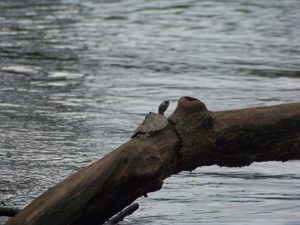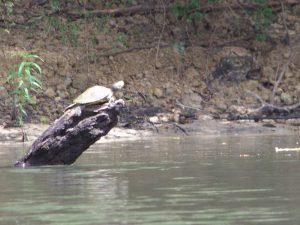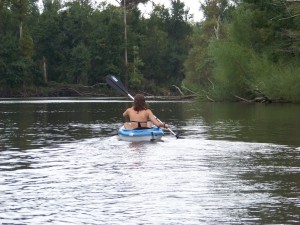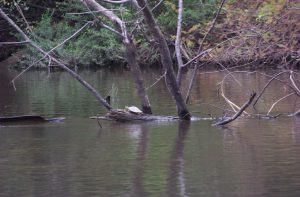Map turtles (Graptemys) are pretty common across much of the eastern and midwest areas of the United States. Not so much in Florida. There are only two species, and they are only found in the panhandle. However, the range for those two species is mostly in Florida making them a unique Florida turtle, and ones that both the state and federal agencies monitor for occurrence.
In the 1940s and 50s it was believed that the Barbour’s Map Turtle (Graptemys barbouri) was only found in the Apalachicola River and the Escambia Map Turtle (Graptemys ernsti) was only found in the Escambia. As a matter of fact, with much of the Escambia River actually in Alabama, they were not sure whether the Escambia Map Turtle was different from the Alabama Map Turtle ( Graptemys pulchra) that inhabits the upper reaches of the Escambia River in Alabama, where they call it the Conecuh River.
Today they do now consider it a separate species and they also know these turtles are found in other rivers in the panhandle. As a matter of fact, there may be more Barbour’s Map Turtles in the Chipola River than in the Apalachicola.
This is definitely a river turtle – preferring stronger currents with plenty of fallen trees (snags) to bask on – something they like to do a lot of. The females are twice as large as the males, with very wide heads and powerful jaws for crushing mollusk shells – their favorite food. Males are much smaller and feed primarily on insects and other aquatic invertebrates. Because of their preference for mollusk, they are usually not found in tannic rivers, like Blackwater or Perdido Rivers, where the pH is to low for successful shell development. And even on the more alluvial rivers, they are not common in the quiet backwater areas of the floodplain swamps – they really like the currents where the mollusk are.
The Barbour’s Map Turtle differs from the Escambia Map in that (a) they have circular yellow patterns on each scute (scale) of the olive green to brown carapace (top shell), (b) lack the two large yellow spots on the top of the head, behind the eye that you find in the Escambia Map, (c) lack the dark black stripe running down the middle keel of the carapace you find in the Escambia Map, (d) the rivers they inhabit.
Barbour’s Map Turtles are found in the rivers between (and including) the Choctawhatchee River and the Apalachicola River. There have been records of Barbour’s Map Turtle in the Ochlockoknee River, but it is believed they may have been moved there by humans.

The Escambia Map Turtle is only found in the Escambia, Yellow, and Shoal Rivers.
Photo: Molly O’Connor
The Escambia Map Turtle is found in rivers that feed into Pensacola Bay. These would include the Escambia, Yellow, and Shoal Rivers – again, Blackwater is too tannic. There is discussion whether the Escambia Map has been found in the Choctawhatchee, and there may be some hybridization occurring here.
On rivers where they are found, map turtles can be some of the most common turtles seen. They have high domes shells, that look more “inflated” towards the head end, and scales that form jagged points sticking up along the mid-line of the shell. This gives them a “dinosaur” appearance and another common name “sawbacks”. They are not big turtles, when compared to others like softshell, cooters, snappers – reaching a maximum shell length of 12 inches – are often seen basking on fallen trees (snags) in the water. They are skittish and hard to get close to. Many will jump into the water when you are still over 300 feet away. But for those patient enough to drift, you should get a closer look, and maybe even a picture. On one paddle I did on the Escambia River they made up over 75% of the turtles we saw in a one-mile stretch.
The Barbour’s Map prefers sections of the river where the current is strong and limestone outcrops are frequent. These limestone sections are home to a variety of snail species – the female’s favorite food. Like so many other turtles, they do have to have sandy beaches for nesting. They will venture downstream to find these where the river makes sharp turns and may venture as far as 350 feet inland looking for a suitable nesting spot. Here raccoons do their damage. They not only consume the eggs but will prey on the adults as well. It is also known that occasionally bald eagles will target map turtles as food.
Times are harder for the Barbour’s Map Turtle. In the 1950s there were reports of as many as 136 map turtles / mile. Today the numbers are more like 5-10. The decline can be attributed to several issues.
1) Human harvest. Though not as frequent today, there are records of human harvesting within their range, particularly in the Chipola River area.
2) Dams. Altering the river flow and available “snags” has impacted their numbers.
3) Removing “snags”. This is done for both navigation issues with boaters and because there are unsightly to some. However, map turtles need them – as do other riverine wildlife.
4) “Plinking”. This is a “sport” that is not as common as it once was, but still happens. This is when humans use basking turtles as target practice.
All of these, and probably others, have contributed to this decline and forced the state to protect them. They are now listed on Florida’s Imperiled Species List and you are not allowed to possess them.
The Escambia Map Turtle is still very common on the Escambia River. However, all the members of this species only live on three short rivers, and Florida is concerned that they numbers could be wiped out with a catastrophic event.
This portion of Florida lacks the limestone substrate you find further east. The Escambia River was home to one of the greatest variety of mussels in the Florida rivers. This is their choice of food over snails. However, pollution from agriculture and a paper mill in the Alabama portion of the river, as well as altered flow and sediments due to dams in the Alabama portion, have caused a decline in the mussels. Interestingly, the non-native Asian Clam was accidentally introduced to all the river systems in the panhandle, and the map turtles love them. Some believe the introduction of the Asian Clam may have “saved” the Escambia Map.
In addition to the stressors mentioned with the Barbour’s Map, the Escambia Map has had problems with local ATVs riding all over their nesting beaches destroying nests. Because of their small geographic range, and the increase in potential threats, Florida prohibits the possession of this map turtle as well.
The cool thing about these map turtles is that they are only found in a small area of the planet – in our north Florida rivers. I hope we can protect them, and that you get to see some one day.
- Our Environment: Part 11 – We Need Water - July 7, 2025
- Our Environment: Part 10 – Improving Agriculture - June 20, 2025
- Marine Creatures of the Northern Gulf – Snails and Slugs - June 20, 2025



